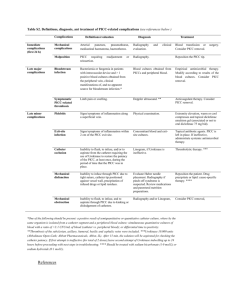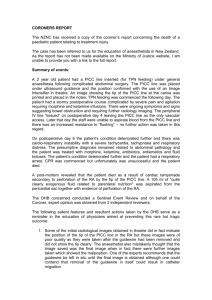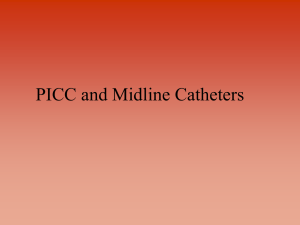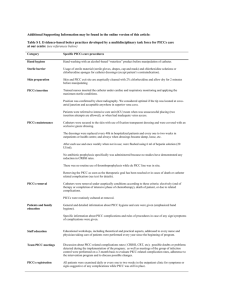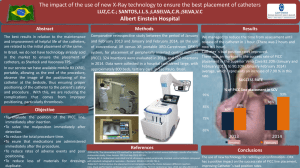n Nuffield Orthopaedic Centre
advertisement
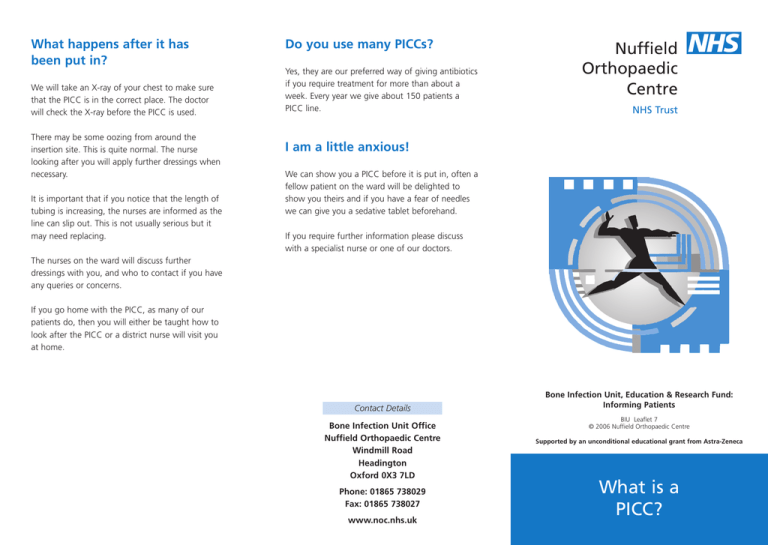
What happens after it has been put in? We will take an X-ray of your chest to make sure that the PICC is in the correct place. The doctor will check the X-ray before the PICC is used. There may be some oozing from around the insertion site. This is quite normal. The nurse looking after you will apply further dressings when necessary. It is important that if you notice that the length of tubing is increasing, the nurses are informed as the line can slip out. This is not usually serious but it may need replacing. Do you use many PICCs? Yes, they are our preferred way of giving antibiotics if you require treatment for more than about a week. Every year we give about 150 patients a PICC line. Nuffield Orthopaedic Centre n NHS Trust I am a little anxious! We can show you a PICC before it is put in, often a fellow patient on the ward will be delighted to show you theirs and if you have a fear of needles we can give you a sedative tablet beforehand. If you require further information please discuss with a specialist nurse or one of our doctors. The nurses on the ward will discuss further dressings with you, and who to contact if you have any queries or concerns. If you go home with the PICC, as many of our patients do, then you will either be taught how to look after the PICC or a district nurse will visit you at home. Contact Details Bone Infection Unit Office Nuffield Orthopaedic Centre Windmill Road Headington Oxford 0X3 7LD Phone: 01865 738029 Fax: 01865 738027 www.noc.nhs.uk Bone Infection Unit, Education & Research Fund: Informing Patients BIU Leaflet 7 © 2006 Nuffield Orthopaedic Centre Supported by an unconditional educational grant from Astra-Zeneca What is a PICC? Introduction This leaflet tells you about PICC lines (Peripherally Inserted Central Catheter), what they are, what they are used for and how they are inserted. What is a PICC? A PICC is a narrow tube that is put into a vein in the arm, usually in the elbow area. It allows your medicines and antibiotics to be given directly into the bloodstream. The tip will lie in a big vein, just near your heart. The PICC can stay in place for weeks to months, depending on your treatment. Usually it is in for 2 to 6 weeks. The risks involved are bleeding, infection, thrombosis (blood clot), phlebitis (inflammation of the vein) and the line could go up into one of the veins in the neck. However, these risks are rare and rarely serious. How is a PICC put in? What does a PICC look like? You will be asked to put your chin on your shoulder of the arm that the line is being inserted into. This is to prevent the PICC going up into one of the veins in the neck. You may feel a “pushing” sensation, but you should not feel any pain. The PICC will be secured at the insertion site with a waterproof dressing. This is an example which would be covered by a thin bandage. You will be able to do most things with this line in you. Some people even return to work depending on their occupation. After deciding on which vein is most suitable to insert the PICC we will clean the area and then give you an injection of local anaesthetic to numb the skin. This usually stings a little. How is it removed? The centre of the PICC is called the lumen. Your PICC may have I or 2 lumens depending upon the treatment you require. A specially trained nurse or doctor will insert the PICC at your bedside, after examining your arm veins to establish your suitability for a PICC device. Are there any risks? You will need to give your written consent before we insert the PICC. We will discuss the risks and benefits of the procedure with you and also answer any questions or concerns. When your course of treatment has finished, the PICC will be removed. This is done by gently pulling the PICC out of your arm, either at home by a district nurse or in outpatients or on the ward.


